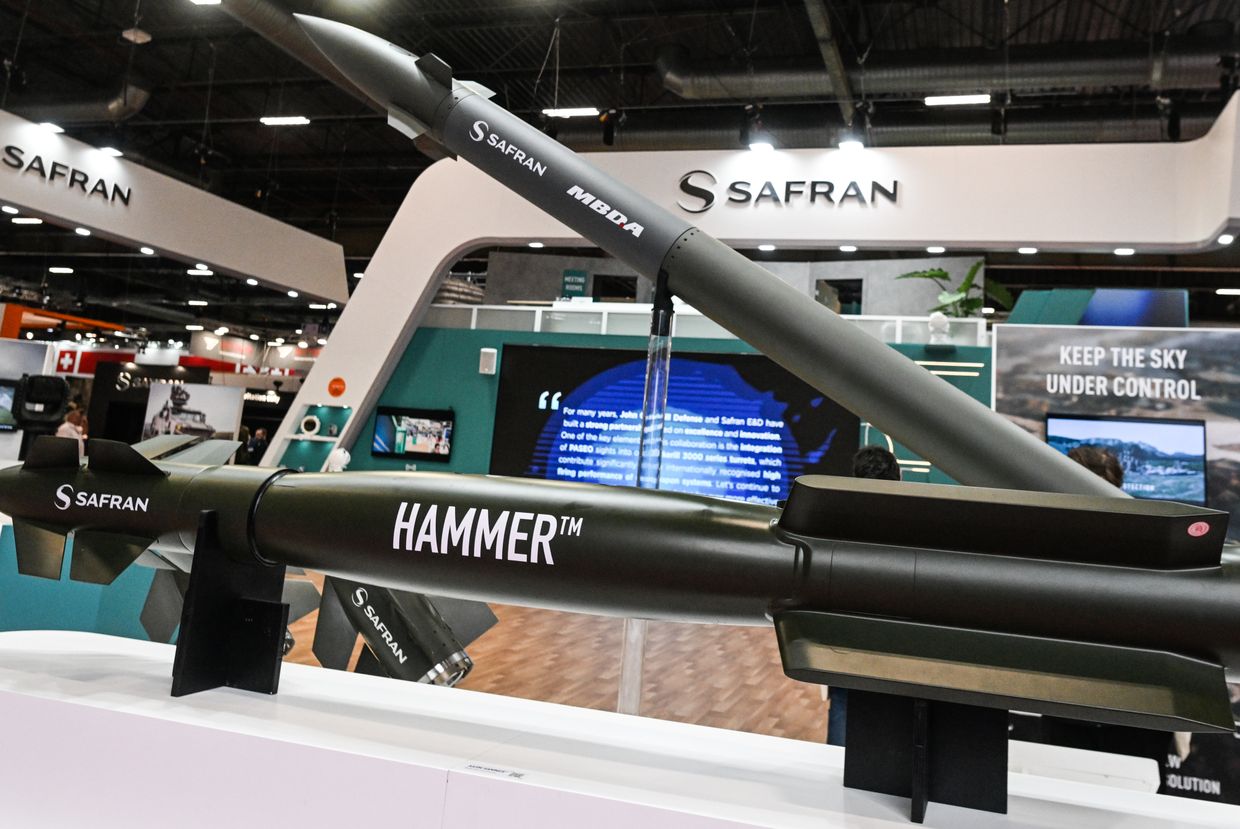In a boon for Kyiv's offensive capabilities, France has announced it will manufacture 1,200 AASM Hammer bombs for Ukraine in 2025.
Glide bombs have become an integral part of both Russia and Ukraine's arsenals, allowing the delivery of powerful payloads for relatively little cost.
The AASM Hammer is one of several modern Western models and has already been used by Ukraine to great effect.
"The pilots of the Ukrainian Air Force speak very positively about this weapon," Viktor Kevliuk, a retired military officer and defense expert, told the Kyiv Independent.
What is a glide bomb?
A glide bomb is a standard air-dropped bomb modified with wings and a navigation system that allows it to be launched from a distance rather than directly over the target.
They're far from a new technology and date back to World War II — the German Fritz X bomb was the first of its type, a 1,560 kg armor-piercing bomb fitted with a radio receiver and designed for use against armored ships.
Other nations developed their own versions, and they've been used for decades in conflicts, including Vietnam, Iraq, and Afghanistan.
Converting a "dumb bomb," an unguided one, into a smart bomb can cost as little as $20,000, making it a much cheaper alternative to cruise and ballistic missiles that cost millions of dollars to produce.
"They're really basic," Fabian Hoffmann, a defense expert and doctoral research fellow at the University of Oslo, told the Kyiv Independent.
"All you need is the glide system that allows the bomb to fly for some distance and then integrate that with a satellite navigation receiver. And that's pretty straightforward," he added.
Russia began using glide bombs to devastating effect in Ukraine in early 2023 to compensate for dwindling numbers of smart munitions and used them against cities near the front lines, causing hundreds of civilian deaths in 2024.

Russia mainly uses Soviet-era FAB-family bombs, upgraded with a Unified Gliding and Correction Module, which includes wings that flip out as the weapon is released by the aircraft and a satellite navigation system.
Despite being one of the most primitive and numerous weapons in the Russian Air Force's arsenal, Ukraine's Western-supplied air defense systems were more geared towards protecting Russia's sophisticated and expensive cruise and ballistic missiles.
"Glide bombs, unlike missiles, do not have a propulsion system, so they don't generate much heat and are therefore largely immune to interception by infrared homing missiles, like the AIM-9 Sidewinder, or the FIM-92 Stinger," Jacob Parakilas, research leader in RAND Europe's Defense, Security and Justice Research Group, told the Kyiv Independent earlier this year.
The range of the weapons also allows the Russian fighter jets that launch them to stay out of range of Ukraine's advanced air defense systems such as the U.S.-supplied Patriot.
Ukraine has instead developed electronic warfare methods to jam the navigation systems of glide bombs, something it has done to great effect in recent months.
Ukraine also has glide bombs supplied by Western allies, including the U.S. Ground-Launched Small Diameter Bombs (GLSDB).
These are more accurate and sophisticated than their Russian counterparts, but Ukraine's arsenal is much more limited, and Russian forces have developed their own electronic countermeasures designed to specifically disrupt their accuracy, rendering them largely ineffective.
What makes the AASM Hammer bomb so effective?
The AASM Hammer (Highly Agile Modular Munition Extended Range) bomb is, in essence, the same as all other glide bombs — wings attached to a dumb bomb and a navigation system.
Developed by French company Safran, it has become a weapon of choice for Ukraine's air force thanks to its high accuracy and resistance to Russian electronic warfare, according to Le Parisien.
Its GPS navigation system can be enhanced with infrared and laser guidance and is specifically designed to function in "GPS-denied" environments — in other words, it's incredibly difficult to jam.
All of this makes them more expensive than the cheapest glide bombs — each unit can cost upwards of $300,000, though they're still cheaper than a Storm Shadow cruise missile (around $1m) for example, and are easier to produce.
How is Ukraine using Hammer bombs?
"The AASM Hammer's extended range and high accuracy make it suitable for targeting logistics hubs, command posts, and high-value assets located beyond the front line," Kevliuk said.
Safran has adapted the bomb so that it can be used by Ukrainian MiG and Su aircraft, something it did "in less than four months in the fall of 2023," according to the company's CEO Franck Saudo.
The weapon entered service with the French military in 2008 and became standard for the Dassault Rafale, a French twin-engine, multirole fighter aircraft. It has since been adapted for use on other aircraft, including the F-16 and Mirage 2000.
France hopes to supply Ukraine with around 50 AASM bombs each month.
They have a maximum range of around 70 kilometers, meaning Ukrainian fighter jets typically launch the bombs near the front line. This requires a fast and low approach to avoid Russian radars before banking sharply upwards to provide the bombs with lift.
Remarkable footage of a Ukrainian Air Force MiG-29 Fulcrum conducting a bombing run with French-supplied AASM Hammer guided bombs.
The Ukrainian MiG screams just a few dozen feet off the ground, pitches up, and lobs the pair of French extended-range bombs at a Russian target. pic.twitter.com/tOQJYfHbiA
According to Hoffmann, the weapons range is somewhat limited by launching in this way, but once launched, there's very little its target can do, even if it manages to see it coming.
"The really nice thing about the munition is that it is quite fast so that makes it difficult to intercept for the Russians as it comes down," he told the Kyiv Independent.
"It is also equipped with a fairly large payload, which means that it can penetrate fortified structures, and then as it explodes, it can cause some really significant damage," he added.
Kherson Oblast, a French-supplied AASM Hammer guided bomb, launched by a Ukrainian MiG-29, slams through the roof of a Russian-occupied warehouse. pic.twitter.com/m0qeA7ECo7
— OSINTtechnical (@Osinttechnical) April 19, 2025In recent months, Ukraine's armed forces have released several videos showing strikes on Russian forces using Hammer bombs.
They've been used against command posts, warehouses, and heavy artillery, and in February, a group of Russian soldiers sheltering under a road bridge was reportedly wiped out using the weapon.
"This is a system for front-line use to really pressure the Russians," Hoffman said.
As Russia trains abducted children for war, Ukraine fights uphill battle to bring them home
Around the world, abducting a child is a serious crime punishable by years behind bars. But when the kidnapper is Russia, justice remains a distant hope. So does the child’s return home. Since the start of the full-scale invasion, Ukraine has identified over 19,500 children who have been


.png)
 German (DE)
German (DE)  English (US)
English (US)  Spanish (ES)
Spanish (ES)  French (FR)
French (FR)  Hindi (IN)
Hindi (IN)  Italian (IT)
Italian (IT)  Russian (RU)
Russian (RU)  4 hours ago
2
4 hours ago
2









Comments